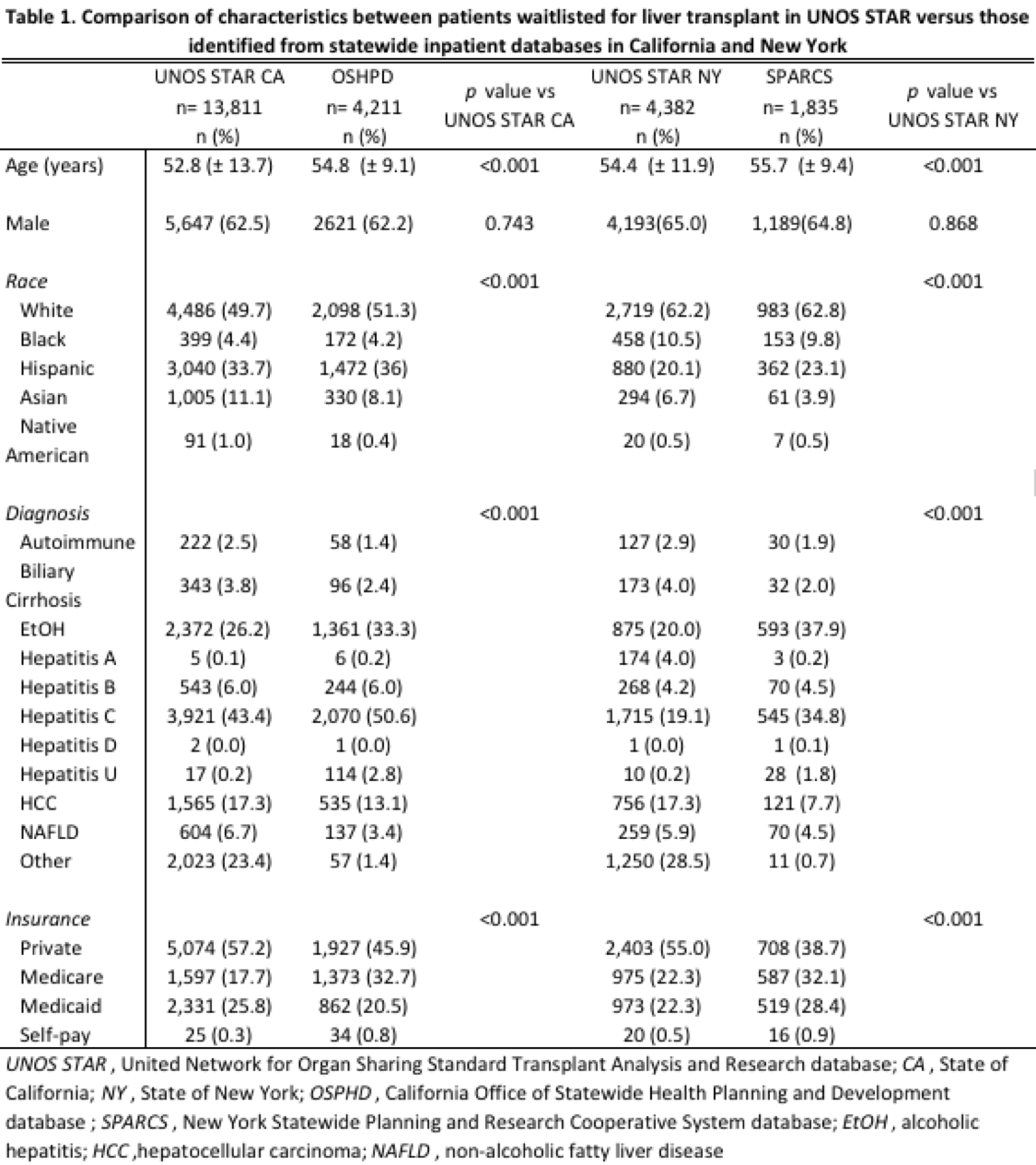Are ICD-9 V Codes Representative of the Liver Transplant Wait List?
Surgery, Massachusetts General Hospital/Harvard Medical School, Boston, MA
Meeting: 2017 American Transplant Congress
Abstract number: C66
Keywords: Liver cirrhosis, Liver transplantation, Public policy, Waiting lists
Session Information
Session Name: Poster Session C: Disparity in Access and Outcomes for Solid Organ Transplantation
Session Type: Poster Session
Date: Monday, May 1, 2017
Session Time: 6:00pm-7:00pm
 Presentation Time: 6:00pm-7:00pm
Presentation Time: 6:00pm-7:00pm
Location: Hall D1
Background: Disparities in liver transplantation once wait listed are well-described, but little is known about how and why only 20% of end-stage liver disease patients (ESLD) make it to the wait list. Statewide inpatient databases offer the possibility to follow ESLD patients, but these patients cannot be linked with UNOS wait lists for direct analysis. We therefore examined if ICD-9 V codes in statewide inpatient databases are representative of the actual liver transplant wait list.
Methods: New York Statewide Planning and Research Cooperative System (SPARCS) and California Office of Statewide Health Planning and Development (OSHPD) inpatient databases were utilized from 2005-2014. We compared the number and demographic distribution of patients with validated ICD-9 codes for cirrhosis and a V code for “awaiting organ transplant” to wait list patients from the UNOS Standard Transplant Analysis and Research database for New York (UNOS STAR NY) and for California (UNOS STAR CA). Patients were excluded if they were previously transplanted or listed for a Status 1 liver.
Results: 13,811 patients were waitlisted in UNOS STAR CA, but only 4,211 (30.5%) had the corresponding V code in OSHPD. Similarly, 4,382 patients were waitlisted in UNOS STAR NY, and only 1,835 (41.9%) had an appropriate V code in SPARCS. Patient age, race, diagnosis, and insurance distributions were significantly different when comparing UNOS STAR NY to SPARCS (all p < 0.001) and UNOS STAR CA to OSHPD (all p < 0.001).  Unadjusted analysis was performed for categorical dependent variables with Chi-square, and for numerical dependent variables with t-test.
Unadjusted analysis was performed for categorical dependent variables with Chi-square, and for numerical dependent variables with t-test.
Conclusion: ICD-9 V codes under-report actual wait list status by 60-70% and the differing demographic distribution make current statewide inpatient databases sub-optimal to study listing patterns. A quality improvement approach should incentivize documentation of ICD-9 V codes. Federal policymakers should consider establishing an ESLD registry similar to the United States Renal Data Service for kidney disease.
CITATION INFORMATION: Bababekov Y, Chang D, Hung Y.-C, Adler J, Stapleton S, Markmann J, Yeh H. Are ICD-9 V Codes Representative of the Liver Transplant Wait List? Am J Transplant. 2017;17 (suppl 3).
To cite this abstract in AMA style:
Bababekov Y, Chang D, Hung Y-C, Adler J, Stapleton S, Markmann J, Yeh H. Are ICD-9 V Codes Representative of the Liver Transplant Wait List? [abstract]. Am J Transplant. 2017; 17 (suppl 3). https://atcmeetingabstracts.com/abstract/are-icd-9-v-codes-representative-of-the-liver-transplant-wait-list/. Accessed December 26, 2025.« Back to 2017 American Transplant Congress
